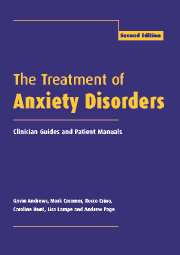Book contents
- Frontmatter
- Contents
- List of authors
- Preface to the second edition
- Abbreviations
- 1 Read me
- 2 General issues in anxiety disorders
- 3 General issues in treatment: Clinician Guide
- 4 Panic disorder and agoraphobia: Syndrome
- 5 Panic disorder and agoraphobia: Treatment
- 6 Panic disorder and agoraphobia: Clinician Guide
- 7 Panic disorder and agoraphobia: Patient Treatment Manual
- 8 Social phobia: Syndrome
- 9 Social phobia: Treatment
- 10 Social phobia: Clinician Guide
- 11 Social phobia: Patient Treatment Manual
- 12 Specific phobias: Syndrome
- 13 Specific phobias: Treatment
- 14 Specific phobias: Clinician Guide
- 15 Specific phobias: Patient Treatment Manual
- 16 Obsessive-compulsive disorder: Syndrome
- 17 Obsessive-compulsive disorder: Treatment
- 18 Obsessive-compulsive disorder: Clinician Guide
- 19 Obsessive-compulsive disorder: Patient Treatment Manual
- 20 Generalized anxiety disorder: Syndrome
- 21 Generalized anxiety disorder: Treatment
- 22 Generalized anxiety disorder: Clinician Guide
- 23 Generalized anxiety disorder: Patient Treatment Manual
- 24 Posttraumatic stress disorder: Syndrome
- 25 Posttraumatic stress disorder: Treatment
- 26 Posttraumatic stress disorder: Clinician Guide
- 27 Posttraumatic stress disorder: Patient Treatment Manual
- 28 Conclusions
- References
- Index
26 - Posttraumatic stress disorder: Clinician Guide
Published online by Cambridge University Press: 05 August 2016
- Frontmatter
- Contents
- List of authors
- Preface to the second edition
- Abbreviations
- 1 Read me
- 2 General issues in anxiety disorders
- 3 General issues in treatment: Clinician Guide
- 4 Panic disorder and agoraphobia: Syndrome
- 5 Panic disorder and agoraphobia: Treatment
- 6 Panic disorder and agoraphobia: Clinician Guide
- 7 Panic disorder and agoraphobia: Patient Treatment Manual
- 8 Social phobia: Syndrome
- 9 Social phobia: Treatment
- 10 Social phobia: Clinician Guide
- 11 Social phobia: Patient Treatment Manual
- 12 Specific phobias: Syndrome
- 13 Specific phobias: Treatment
- 14 Specific phobias: Clinician Guide
- 15 Specific phobias: Patient Treatment Manual
- 16 Obsessive-compulsive disorder: Syndrome
- 17 Obsessive-compulsive disorder: Treatment
- 18 Obsessive-compulsive disorder: Clinician Guide
- 19 Obsessive-compulsive disorder: Patient Treatment Manual
- 20 Generalized anxiety disorder: Syndrome
- 21 Generalized anxiety disorder: Treatment
- 22 Generalized anxiety disorder: Clinician Guide
- 23 Generalized anxiety disorder: Patient Treatment Manual
- 24 Posttraumatic stress disorder: Syndrome
- 25 Posttraumatic stress disorder: Treatment
- 26 Posttraumatic stress disorder: Clinician Guide
- 27 Posttraumatic stress disorder: Patient Treatment Manual
- 28 Conclusions
- References
- Index
Summary
PTSD is a complex disorder requiring a multistaged intervention. The core components of treatment – psychoeducation, anxiety management, exposure, and cognitive restructuring – overlap with interventions used in the treatment of many other anxiety disorders. The purpose of this chapter is to discuss the application of those strategies to the specific challenges of PTSD, as well as to highlight some contextual treatment issues. Although the field of acute stress disorder (ASD) is in its infancy, preliminary research indicates that the same treatment protocols are applicable to both disorders. Under most circumstances, however, it would be expected that the treatment of ASD would be simpler, and would proceed at a faster rate, than treatment of more chronic PTSD presentations.
The bulk of this chapter addresses the treatment of PTSD as a disorder in itself. In acute presentations, and in people with good pretrauma functioning and intact support networks, such approaches may be all that is required. In most cases, however, by the time the person seeks treatment, the PTSD has become embedded in a range of comorbid conditions and psychosocial dysfunction. This chapter will begin by addressing some of the issues associated with more complex cases before discussing the primary treatment components in detail.
Assessment issues
A detailed discussion of assessment strategies for PTSD was provided in Chapter 24. The purpose of this section is to elucidate some additional factors to be considered when assessing for treatment purposes. A thorough assessment of the patient's history, current psychosocial functioning, and diagnosis is required before an adequate formulation of the case can be made and a management plan developed. A detailed discussion of psychiatric interviewing is beyond the scope of this chapter and only those issues particularly relevant to survivors of trauma will be discussed in this section. Key issues to look for in the history include previous episodes of psychiatric disorder (or simply “bad nerves”), as well as prior treatment experience and pretrauma coping strategies. Identification of these factors will assist in the formulation of realistic treatment goals and selection of intervention strategies with an improved chance of success. It is important also to take a history of prior traumatic experiences. Clearly, this latter area may be highly sensitive and relevant information may not necessarily emerge in the first session.
- Type
- Chapter
- Information
- The Treatment of Anxiety DisordersClinician Guides and Patient Manuals, pp. 492 - 511Publisher: Cambridge University PressPrint publication year: 2002



